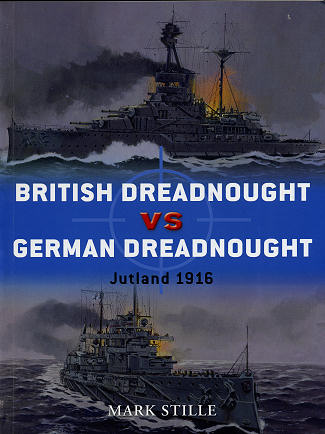 World
War I was the first opportunity for the new Dreadnought class of battleship and
the new battlecruiser to have an opportunity to see action. As the Dreadnought
was a British design and as the British had a well developed ship-building
industry, it was not surprising that they built quite a few of them and were
able to do so rather quickly. The only other nation that was building a lot of
these ships was Germany. They didn't have the ability to build their ships as
rapidly, so when the war came, they were pretty much outmatched about two to one
in terms of capital ships.
World
War I was the first opportunity for the new Dreadnought class of battleship and
the new battlecruiser to have an opportunity to see action. As the Dreadnought
was a British design and as the British had a well developed ship-building
industry, it was not surprising that they built quite a few of them and were
able to do so rather quickly. The only other nation that was building a lot of
these ships was Germany. They didn't have the ability to build their ships as
rapidly, so when the war came, they were pretty much outmatched about two to one
in terms of capital ships.
There were major differences in these ships from the two
countries. The British went for larger guns, oil fueled turbines for power and a
less armor for their ships in order to have greater speed. This was particularly
true of the battlecruisers, whose purpose was not to engage dreadnought ships,
but smaller armored cruisers. It turns out that both sides used these ships in
the main battle line, much to the regret of the crews (mainly British) whose
lives were lost when these ships were so easily destroyed. But that is another
story.
The Germans, on the other hand, used older coal fired
engines, had somewhat smaller guns, and generally had more armor on their ships.
Such was the case that even German battlecruisers had as much armor on them as
did some British dreadnoughts. This alone prevented the loss of several German
ships of this class.
In other respects, the British used gunpowder that easily
exploded, while the Germans used a type that did not. British gunnery and
rangefinding equipment was also inferior to the Germans, who despite having
smaller guns, were able to have a higher hit percentage than the British.
Finally, both sides suffered from leadership that made mistakes during battle.
Though Gemany's Sheer made some errors, it seems thatBritain's Jellico make
quite a few of them. This resulted in lost opportunities for the British, more
British ships sunk and the eventual escape somewhat unscathed by the slower
German battle fleet after the Jutland battle.
Author Mark Stille is known for his writings on naval
subjects and brings that expertise to this book on the opposing ships and their
performance at Jutland in 1916. He discusses the
development of both ship types as well as their technical specifications and
deployments during the war. The Jutland battle takes up a goodly section of the
book and we can see through current analysis of the event, how the battle
progressed and how the opposing leaders saw events unfold. We are able to look
at the judgment used by these men and how the battle affected the rest of the
naval war.
In all, a superlative inclusion to this series and one that I
know you will find to be a fascinating read.
October 2010
For more on the complete line of Osprey books,
visit www.ospreypublishing.com. In the US, it is
Osprey Direct at 44-02 23rd St, Suite 219, Long Island City, NY 11101., where you can
get a catalogue of available books.
If you would like your product reviewed fairly and quickly, please contact
me or see other details in the Note to
Contributors.
 World
War I was the first opportunity for the new Dreadnought class of battleship and
the new battlecruiser to have an opportunity to see action. As the Dreadnought
was a British design and as the British had a well developed ship-building
industry, it was not surprising that they built quite a few of them and were
able to do so rather quickly. The only other nation that was building a lot of
these ships was Germany. They didn't have the ability to build their ships as
rapidly, so when the war came, they were pretty much outmatched about two to one
in terms of capital ships.
World
War I was the first opportunity for the new Dreadnought class of battleship and
the new battlecruiser to have an opportunity to see action. As the Dreadnought
was a British design and as the British had a well developed ship-building
industry, it was not surprising that they built quite a few of them and were
able to do so rather quickly. The only other nation that was building a lot of
these ships was Germany. They didn't have the ability to build their ships as
rapidly, so when the war came, they were pretty much outmatched about two to one
in terms of capital ships.